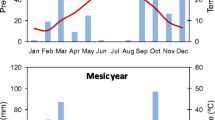Abstract
Rising atmospheric CO2 may lead to natural selection for genotypes that exhibit greater fitness under these conditions. The potential for such evolutionary change will depend on the extent of within-population genetic variation in CO2 responses of wild species. We tested for heritable variation in CO2-dependent life history responses in a weedy, cosmopolitan annual, Raphanus raphanistrum. Progeny from five paternal families were grown at ambient and twice ambient CO2 using outdoor open-top chambers (160 plants per CO2 treatment). Elevated CO2 stimulated net assimilation rates, especially in plants that had begun flowering. Across paternal families, elevated CO2 led to significant increases in flower and seed production (by 22% and 13% respectively), but no effect was seen on time to bolting, leaf area at bolting, fruit set, or number of seeds per fruit. Paternal families differed in their response to the CO2 treatment: in three families there were no significant CO2 effects, while in one family lifetime fecundity increased by >50%. These genotype-specific effects altered fitness rankings among the five paternal families. Although we did not detect a significant genotype x CO2 interaction, our results provide evidence for heritable responses to elevated CO2. In a subset of plants, we found that the magnitude of CO2 effects on fecundity was also influenced by soil fertility.
Similar content being viewed by others
References
Barnes JD, Pfirrmann T (1992) The influence of CO2 and O3, singly and in combination, on gas exchange, growth and nutrient status of radish (Raphanus sativus L.). New Phytol 121:403–412
Chu CC, Coleman JS, Mooney HA (1992) Controls of biomass partitioning between roots and shoots: atmospheric CO2 enrichment and the acquisition and allocation of carbon and nitrogen in wild radish. Oecologia 89:580–587
Clough JM, Peet MM, Kramer PJ (1981) Effect of high atmospheric CO2 and sink size on rates of photosynthesis of a soybean cultivar. Plant Phys 67:1007–1010
Conway TJ, Tans P, Waterman LS, Thoning KW, Maserie KA, Gammon RM (1988) Atmospheric carbon dioxide measurements in the remote global troposphere. Tellus 40B: 81–115
Curtis PS, Teeri JA (1992) Seasonal responses of leaf gas exchange to elevated carbon dioxide in Populus grandidentata. Canadian J For Res 22:1320–1325
Fajer ED, Bowers MD, Bazzaz FA (1992) The effect of nutrients and enriched CO2 environments on production of carbonbased allelochemicals in Plantago: A test of the carbon/nutrient balance hypothesis. Am Nat 140:707–723
Garbutt D, Bazzaz FA (1984) The effects of elevated CO2 on plants III. Flower, fruit and seed production and abortion. New Phytol 98:433–446
Geber MA, Dawson TE (1992) Evolutionary responses of plants to global change, pp 179–197 in: Karieva PM, Kingsolver JG, Huey RB (eds), Biotic interactions and global change. Sinauer Associates, Inc, Sunderland, MA, USA
Heagle AS, Philbeck RB, Rogers HH, Letchworth MB (1979) Dispensing and monitoring ozone in open-top field chambers for plant effects studies. Phytopathology 69:15–20
Hunt R, Hand DW, Hannah MA, Neal AM (1991) Response to CO2 enrichment in 27 herbaceous species. Funct Ecol 5:410
Idso SB, Kimball BA (1989) Growth response of carrot and radish to atmospheric CO2 enrichment. Env Exp Bot 29:135–139
Kimball BA (1983) Carbon dioxide and agricultural yield: an assemblage and analysis of 430 prior observations. Agron J 75:779–788
Mazer SJ (1987a) Parental effects on seed development and seed yield in Raphanus raphanistrum: Implications for natural and sexual selection. Evolution 41:355–371
Mazer SJ (1987b) The quantitative genetics of life history and fitness components in Raphanus raphanistrum L. (Brassicaceae): Ecological and evolutionary consequences of seedweight variation. Am Nat 130:891–914
Mazer SJ, Schick CT (1991) Constancy of population parameters for life history and floral traits in Raphanus sativus L. I. Norms of reaction and the nature of genotype by environment interactions. Heredity 67:143–156
Mazer SJ, Wolfe LM (1992) Planting density influences the expression of genetic variation in seed mass in wild radish (Raphanus sativus L. Brassicaceae). Am J Bot 79:1185–1193
Mazer SJ, Snow AA, Stanton ML (1986) Fertilization dynamics and parental effects upon fruit development in Raphanus raphanistrum: Consequences for seed size variation. Am J Bot 73:500–511
Overdieck D, Reid CH, Strain BR (1988) The effects of preindustrial and future CO2 concentrations on growth, dry matter production and the C/N relationship in plants at low nutrient supply: Vigna unguiculata (Cowpea), Abelmoschus esculentus (Okra) and Raphanus sativus (Radish). Angew Botanik 62:119–134
Peet MM, Huber SC, Patterson DT (1986) Acclimation to high CO2 in monoecious cucumbers. II. Carbon exchange rates, enzyme activities, and starch and nutrient concentrations. Plant Physiol 80:63–67
Reekie EG, Bazzaz FA (1991) Phenology and growth in four annual species grown in ambient and elevated CO2. Can J Bot 69:2475–2481
Samson DR (1967) Frequency and distribution of self-incompatibility alleles in Raphanus raphanistrum. Genetics 56:241–251
SAS Institute (1989) SAS/STAT user's guide, version 6, fourth edition, volume 2, Cary, NC, USA, SAS Institute Inc
Sokal RR, Rohlf FJ (1981) Biometry. W H Freeman and Co, New York
Stanton ML (1984a) Developmental and genetic sources of seed weight variation in Raphanus raphanistrum L. (Brassicaceae). Am J Bot 71:1090–1098
Stanton ML (1984b) Seed variation in wild radish: effects of seed size on components of seedling and adult fitness. Ecology 65:1105–1112
Stanton ML (1985) Seed size and emergence time within a stand of wild radish (Raphanus raphanistrum L.): the establishment of a fitness hierarchy. Oecologia 67:524–531
Stanton ML, Preston RE (1988) Ecological consequences and phenotypic correlates of petal size variation in wild radish, Raphanus sativus (Brassicaceae). Am J Bot 75:528–539
Wulff RD, Alexander HM (1985) Intraspecific variation in the response to CO2 enrichment in seeds and seedlings of Plantago lanceolata L. Oecologia 66:458–460
Ziska LH, Teramura AH (1992) Intraspecific variation in the response of rice (Oryza sativa) to increased CO2-photosynthetic, biomass and reproductive characteristics. Physiol Plant 84:269–276
Author information
Authors and Affiliations
Rights and permissions
About this article
Cite this article
Curtis, P.S., Snow, A.A. & Miller, A.S. Genotype-specific effects of elevated CO2 on fecundity in wild radish (Raphanus raphanistrum). Oecologia 97, 100–105 (1994). https://doi.org/10.1007/BF00317913
Received:
Accepted:
Issue Date:
DOI: https://doi.org/10.1007/BF00317913




